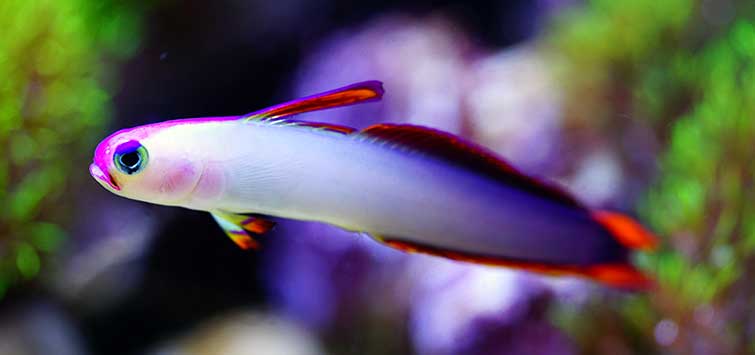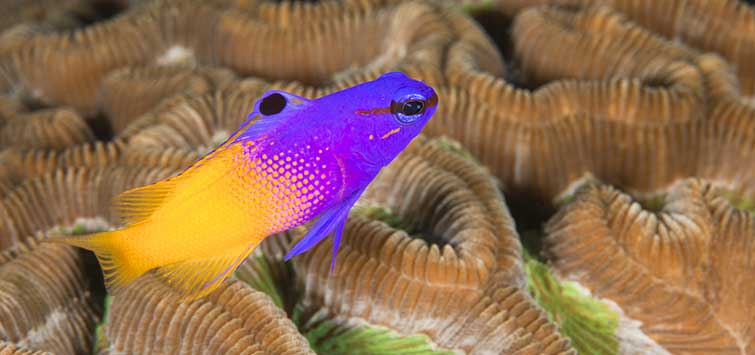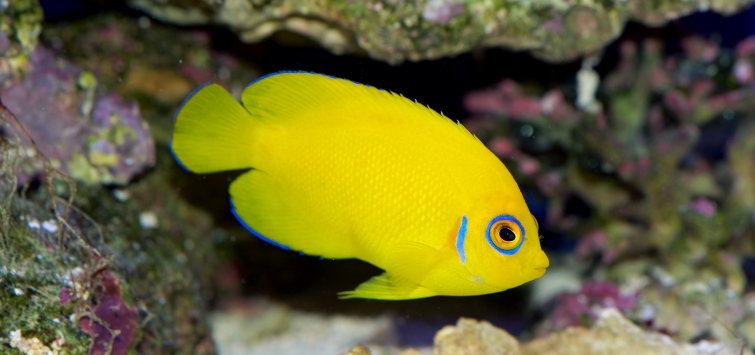Superb Pinks and Purples
Author: Richard Aspinall
In the final installment of his series on selecting marine fishes by color, a reefkeeper and diver lists some species that will add some pink and purple to your tank’s palette.
Two Dazzling Colors
This is the last of my series on color-themed marine fishes. As I have mentioned previously, we really need to be as informed as possible about the fishes that we are considering purchasing for our aquariums. It’s no use waking up one morning and saying to yourself, “You know, I really need some purple fish in my tank to complete my collection,” going to the store, handing over some cash, and then finding out just how hard those beautiful Pseudanthias pascalus anthias are to keep alive when they looked so full of life in the dealer’s tanks.
That is not how fishkeeping should be carried out. It is detrimental to your bank balance, and, above all, it is an insult to the animals removed from the reef that may well starve for lack of adequate nutrition. I often suggest that marine aquarists and the hobby would be better off if we bought fewer fishes that lasted a lot longer in our aquariums, and if we had to pay more for them, fine.
Plan Before You Buy
With all marine-related purchases, then, you should do your research and buy only the fishes you know you can keep—and absolutely never buy on a whim! So if you feel you need a splash of purple or a touch of pink in your system and you’re prepared to learn about the fishes that can provide it for you, read on for my guide to the best of the pinks and the purples.
Painted Frogfish (Antennarius pictus)
Location and Size: Indo-Pacific, about 2½ to 2¾ inches (6 to 7 cm)
Coloration
Antennarius pictus comes in a wonderful array of colors, ranging from creamy whites to deep reds, with the occasional yellow or golden individual thrown in for good measure. Happily for me they are also available in pinks and lilac shades. Frogfishes are masters of camouflage. With skin coloration and texture that closely match corals, sponges, colonial tunicates, and other benthic organisms, they are almost impossible to spot in the wild without a well-trained eye.
The lumpy nature of the painted frogfish’s body, the dark patches that break up its outline, and its ability to change color definitely make this fish a master of mimicry—a necessity for this soft-bodied fish, which has no scales or defense mechanisms other than its cryptic nature.
Movement
The frogfishes in general are small and rarely move; their lifestyle limits them to a very small range, as they seldom move from a coral head or encrusted rock formation. This makes them ideal for aquaria. These fishes have also lost a great deal of their ability to swim with vigor; instead they move around with a walking-type gait, using modified pectoral and pelvic fins that, along with their robust faces, give them their frog-like appearance.
Luring Prey
Don’t let their apparent meekness fool you, though; these fishes are in the order Lophiiformes—the anglerfishes. They are patient predators with large mouths that will engulf any prey that they can entice into range using a fishing-pole-like dorsal spine tipped with a fleshy “lure.”
Tank Parameters
In captivity, they can be kept in small systems as long as the water quality is sufficiently high and skimming and other filtration is adequate to cope with their waste products. Many will require live prey, such as river shrimp, to initiate a feeding response; some authors still recommend using live feeder fishes, but not all specimens find this unappealing. Captive Antennarius species will take frozen meaty foods such as lancefish; when a lancefish is offered on the end of a stick, some form of movement may be required to convince the frogfish to bite. It goes without saying that frogfishes are best kept without smaller fishes and crustaceans that they will regard as prey.
If you wish to observe frogfishes closely it is best to keep them in a small system. They are reported to suffer from stress, which is another reason to keep them singly, and of course you should minimize stress from handling and maintenance.
Dottybacks
There are a good few dottybacks that really pack a purple punch. In a previous article I mentioned the good old royal gramma (Gramma loreto), as a yellow fish “dipped” in purple paint, so I mention this mainstay of the trade in passing, as I do the similarly colored royal dottyback (Pictichromis paccagnellae). But both of these fishes have some excellent relatives that are entirely purple.
Gramma melacara
I’ll start with the blackcap basslet (Gramma melacara). This wonderful fish, which tops out at around 4 inches (10 cm) and hails from the western central Atlantic, is regarded as one of the less boisterous of its kin and requires a fairly peaceful tank. Like G. loreto it is reef-safe but may eat the occasional small shrimp. Easily fed on small meaty foods, G. melacara is hardy and disease resistant. In addition they have wonderful and detailed markings that trim some of their fins, gill covers, and eye region. Individuals are pretty much, by any definition, perfect aquarium fish.
They are prone to losing their color somewhat. The cause of this issue is debatable, though I believe it is likely to be a mixture of water quality and nutrition issues rather than one straightforward factor; pigment-enriched food is reported to help the condition. In addition to proper nutrition, offer blackcap basslets plenty of hiding spaces and avoid closely related or overly aggressive species as tankmates. Meet these needs, and you will have fish that will stay with you for many years.
Pseudochromis fridmani
A species that is similar in looks and care requirements is the wonderful orchid dottyback (Pseudochromis fridmani) from the Red Sea, which reaches around 2¾ inches (7 cm). This once very expensive fish is now commonly bred in captivity (both at home and for the trade) and is a fish that everyone ought to keep for its stunning beauty and its personality. I cannot think of a better purple fish than this. In the wild this species occupies small territories that it defends vigorously, making it ideal for nano systems.
Pictichromis porphyrea
Should you wish to have something a little different you could try the magenta dottyback (Pictichromis porphyrea) of the western Pacific. This all-purple fish is very similar (except for its full immersion in the tin of purple paint) to P. paccagnellae and the rarer P. dinar. It is one of the more amenable fishes in the dottyback clan and has similar care requirements.
Pink Skunk Clownfishes (Amphiprion akallopisos and A. perideraion)
Location and Size: Indo-West Pacific and western Pacific, to around 4 inches (10 cm)
Coloration
When we think of clowns we usually have an orange fish in mind, though these days we may be seeing all-black or black-and-white fish with the wonderful color morphs being produced. There are, however, a few clownfishes that have a distinctly pinkish hue. These are the delicately colored skunk clowns, so named for the characteristic white stripe that runs atop their bodies.
Some morphs do have a peachy tinge to them, but most are a delicate pink. A. perideraion has a white stripe running vertically behind the eye; that stripe is lacking in A. akallopisos. Both reach around 4 inches (10 cm), making them entirely suitable for small systems.
In Captivity
Both species will nestle in commonly kept anemone species in captivity, and both are as easy to feed as the majority of the clownfishes, taking a wide range of aquarium fare. They can of course be territorial when defending an anemone, and the female can bully any male she does not accept, so bear that in mind.
I would recommend seeking out captive-bred specimens (which should be quite easy); they tend to be hardier and of course are more sustainable. Both A. akallopisos and A. perideraion are suitable for beginners, though beginners are advised to avoid keeping an anemone until they are a little more experienced. The clowns won’t mind and will be fine without a host in captivity—a state never found in nature, of course.
Choat’s Leopard Wrasse (Macropharyngodon choati)
Location and Size: Western Pacific, to around 3 inches (7.6 cm)
There are a great number of wrasses with a pink coloration, but in my opinion none so wonderful as Choat’s leopard wrasse (Macropharyngodon choati). I’ve never owned this species; my tank is home to a vermiculate leopard wrasse (M. bipartitus) that I acquired from an aquarist who was leaving the hobby, and I wouldn’t want to disrupt the status quo. I have always been wary of buying fishes from the genus Macropharyngodon, as they have a reputation for being difficult to feed, especially when first added to the aquarium. That is why I would suggest that Choat’s wrasse is for the aquarist with a well-stocked refugium and a system with a healthy population of microfauna that can support a fish with “feeding challenges.”
Acclimation and Feeding
M. choati, if acclimated and adapted to aquarium life (which is by no means certain), will become a fine addition to the aquarium. It is reef-safe, visible, and an all-round charming fish that will not trouble any other species other than perhaps those from its own genus. M. choati will take live foods with gusto, relishing mysid shrimp, though I have to admit that my M. bipartitus will eat pretty much anything, from nori to flake!
Physical Appearance
M. choati’s coloration resembles that of its relatives, but instead of the blacks and greens that tend to predominate in the genus, it has pink patches on a white background, and these patches get better with age. Males of the species have a striking pattern on the head and lower jaw that is reminiscent of the pattern found in some of the Halichoeres wrasses.
Pink-streaked Wrasse (Pseudocheilinops ataenia)
Location and Size: Western central Pacific, to around 2¼ inches (6 cm)
This diminutive and shy wrasse often goes unnoticed in dealers’ tanks; that’s a shame, as it is one of the most charming of its genus and perhaps even its family. Superficially it resembles its larger and more boisterous relative the sixline wrasse (Pseudocheilinus hexataenia), which has bullied many a tank over the years.
Behavior
P. ataenia has a similar lifestyle in that it swims amongst the rockwork and rubble zones picking out small crustaceans and worms that it spots with its large and ever-so-mobile eyes, which often remind me of a cartoon character with thick bottle-bottom glasses. While it may not be as boldly colored as its cousin, it makes up for its lack of bold color by its gentle and peaceful nature. It is rarely aggressive and will remain hidden if more boisterous fishes are present.
Captive Care
Due to its size it is an ideal fish for smaller and nano systems. Feeding is straightforward—small pieces of meaty foods and frozen preparations are ideal. Males have a little more coloration than females and a more pronounced pattern on the gill area. This is an easy and widespread species that would make an ideal fish for the beginner.
Laboute’s Fairy Wrasse (Cirrhilabrus laboutei)
Location and Size: Western central Pacific, to around 4¾ inches (12 cm)
While the Cirrhilabrus species that are commonly offered for sale are, if averaged out into one fictional fish, mainly red (just), I’d argue that the most purple of the clan is C. laboutei. Typical of this genus, the fish is around 4 inches (10 cm) at full size and reef-safe, though it may eat some shrimps, making it another ideal tank inhabitant.
It is also, as one author described it, “eminently peaceable.” Like other cirrhilabrids, C. laboutei can be shy at first and should be kept without aggressive tankmates), but when accustomed to aquarium life it will be bold and constantly on the go.
Firefishes (Nemateleotris helfrichi and N. decora)
Location and Size: Pacific and Indo-Pacific, to around 2¼ inches (6 cm) and 3½ inches (9 cm)
Heflfrich’s firefish (Nemateleotris helfrichi) and the purple firefish (N. decora) have become firm favorites in the hobby. Stunningly colored, reef-safe, and small enough for pretty much any tank other than a true nano, they are understandably popular.
Feeding and Tankmates
Both species (and I suppose I should probably include N. magnifica) are easily fed, hardy, and tolerant of species other than those of their own genus, though they are happier when kept with tankmates that won’t bother them either. They often look very attractive when at the holding station, oriented into the current and just over the substrate in a dealer’s tanks in a group, but they are best kept singly. Unless you can acquire a known pair, individuals will not tolerate other specimens of the same or similar species.
Physical Appearance
N. decora is a striking animal, with cream to pink flanks and deep purple coloration on the head, dorsal surface, and rear. N. helfrichi, which costs a little more than its shallower-dwelling relative, has an even more striking color pattern, with a yellow head, purple eye stripe, and a lilac body. The first few rays of the dorsal fin, used to such great effect by fishes of this genus, are half sky blue and half black. Although these fish may have a slightly “grumpy” look to them, they are undoubtedly gorgeous!
Jumpers
One note of caution, though: they can be jumpers when spooked, so be sure to cover your aquarium and try to avoid rapid changes in light intensity.
Anthias
There are several Pseudanthias species that can be described as purple or pink. In the introduction I mentioned P. pascalus, the purple queen anthias, a fish that looks remarkable even on its own but is a show-stopper when seen in a school. This, though, is one of those hard-to-keep anthias; it needs frequent feedings and exceptional water quality. Considered by some to be a little easier to keep is P. tuka, though I would suggest that this too is an expert-only fish.
Many of the pink and purple anthias tend towards the difficult end of the spectrum, with P. smithvanizi and P. randalli being equally beautiful and equally difficult. I have seen P. tuka and P. pascalus kept in captivity, but only in very large systems with a great deal of food being offered regularly.
The aquarist is perhaps better advised to look at keeping easier species such as P. bartlettorum or P. dispar. They are two of the easier anthias that can be kept in large groups in larger tanks or singly in average systems (it will not miss its brethren). The anthias are one group that you most definitely need to consider with great care before purchase.
So that’s my look at pinks and purples. As ever, do your research and be prepared.

.png?h=595&iar=0&w=2781&hash=5FD5E69473BCC22199FBFA2FB71B6033)



